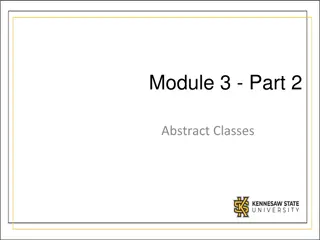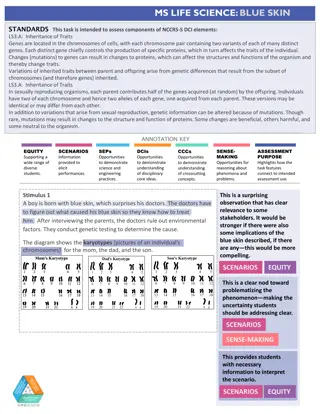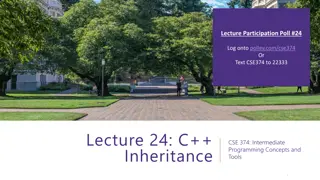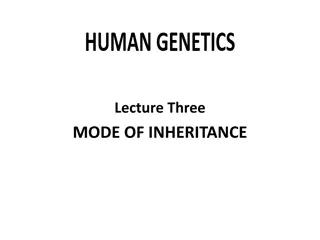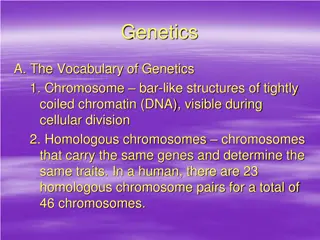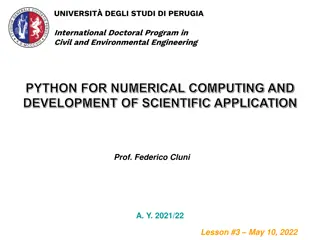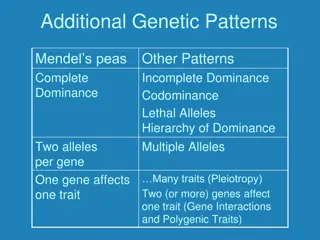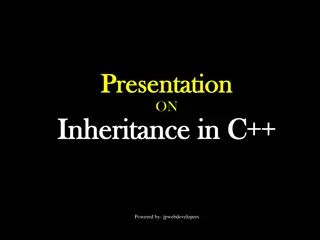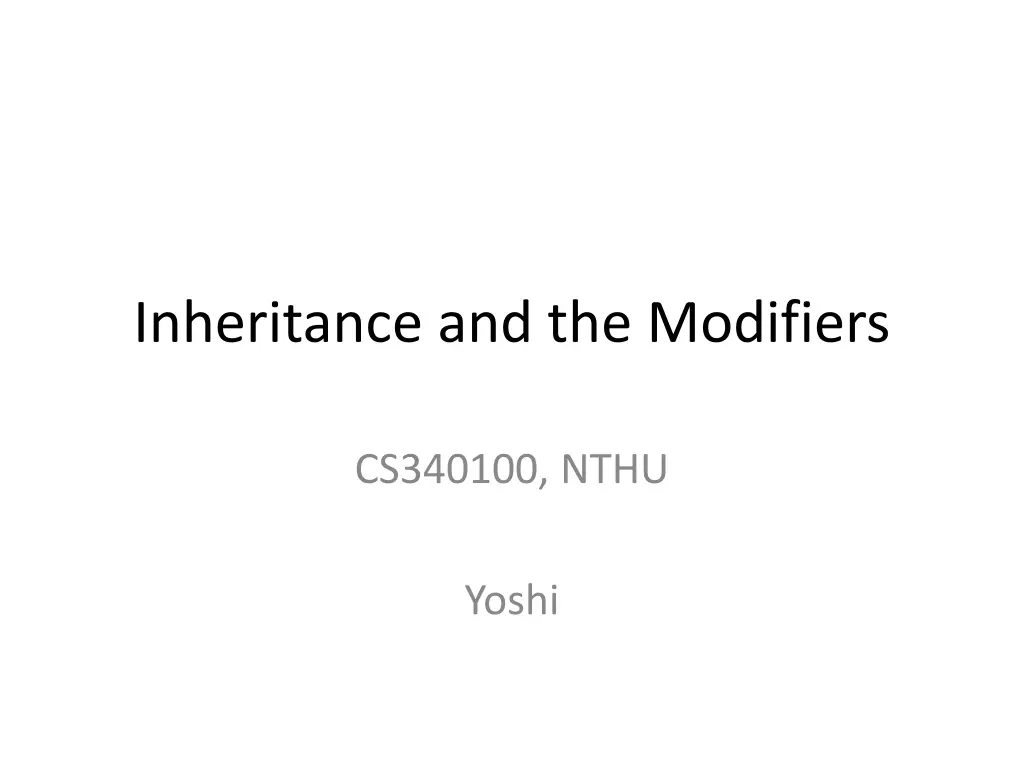
Understanding Inheritance and Modifiers in Java
Explore the fundamental concepts of inheritance and modifiers in Java programming, including examples of subclassing, method overriding, and the use of keywords like final, abstract, and interface. Learn how inheritance promotes code reuse and allows classes to inherit behaviors and states while maintaining their own unique characteristics.
Download Presentation

Please find below an Image/Link to download the presentation.
The content on the website is provided AS IS for your information and personal use only. It may not be sold, licensed, or shared on other websites without obtaining consent from the author. If you encounter any issues during the download, it is possible that the publisher has removed the file from their server.
You are allowed to download the files provided on this website for personal or commercial use, subject to the condition that they are used lawfully. All files are the property of their respective owners.
The content on the website is provided AS IS for your information and personal use only. It may not be sold, licensed, or shared on other websites without obtaining consent from the author.
E N D
Presentation Transcript
Inheritance and the Modifiers CS340100, NTHU Yoshi
Outline Inheritance Basic concept Overriding super Modifiers final abstract interface
Inheritance Inheritance is Aka Generalization/Specialization principle In Java, use the keyword extends 1-3
Why to Inherit? Reuse A subclass can have the states and behaviors from the superclass Extract the common parts A subclass can still have its own behaviors and states Original methods can still be overridden 1-4
Example class Person class Student
An Example: Person and Student public class Person { private String name; private boolean gender; public Person(String name2, boolean gender2) { name = name2; gender = gender2; } public String getName() { return name; } public boolean getGender() { return gender; } } 1-7
Use of Person public class App { public static void main(String argv[]){ Person myPerson=new Person( John , true); String name = myPerson.getName(); boolean gender = myPerson.getGender(); System.out.println(name); System.out.println(gender); } } 1-8
A Subclass : Student public class Student extends Person { private String ID; public void setID(int id2){ ID = id2; } public void getID(){ System.out.print( ID is + ID); } } 1-9
Use of Student public class App { public void main(String argv[]) { Student myStudent=new Student(); //what if: Person myStudent = new Student(); myStudent.setName( John ); myStudent.setGender(true); myStudent.setID( 123456 ); myStudent.getName(); myStudent.getGender(); myStudent.getID(); } } 1-10
Overriding Also known as method rewrite Rewrite a instance method inherited from the superclass Note that a static method can not be overridden A subclass can have a field/method which has the same name as the one derived from the superclass This is called field/method hiding 1-11
Example class Superclass { public static void staticMethod() { System.out.println("Superclass static method."); } public void instanceMethod() { System.out.println("Superclass instance method."); } } class Subclass extends Superclass{ public static void staticMethod() { System.out.println("Subclass static method."); } public void instanceMethod() { System.out.println("Subclass instance method."); } }
Example (contd) public class Test { public static void main(String[] args) { Subclass obj = new Subclass(); //static method Superclass.staticMethod(); Subclass.staticMethod(); //instance method obj.instanceMethod(); ((Superclass) obj).instanceMethod(); } }
this and shadow Shadow effect: the local variable shadows the member in the class Use this to solve the problem Remember how we use this in the previous slide? class Car{ public int wheel; class Car{ public int wheel; Car(int wheel){ wheel = wheel; } Car(int wheel){ this.wheel = wheel; } } } 1-14
this and shadow (contd) this for this stands for the object itself Actually, this saves the address of the object which is executing this line of code this is also used for indicating the shadowed variable 1-15
super super is for indicating the superclass of current class super.fieldNameInSuperclass; super.methodNameInSuperclass(); super() calls the constructor of the superclass If you don t write it, the compiler will add super() for you That is, calling the no-arg constructor super() need to be placed in the first line of the subclass s constructor 1-16
Superclass Superclass object Subclass object Subclass
Wrong program // Vehicle class Vehicle { Vehicle(String x){ System.out.println( Vehicle s Constructor ); } public void drive(){ System.out.println( I m driving ); } } 1-18
Wrong program // Car extend Vechicle class Car extends Vehicle { } public class App{ public static void main(String[] args){ Car aCar=new Car(); } } Why this program is wrong?? 1-19
How to fix it! // Vehicle class Vehicle { Vehicle(){ System.out.println( Vehicle s Constructor ); } Vehicle(String x){ System.out.println( Vehicle s Constructor ); } public void drive(){ System.out.println( I m driving ); } } 1-20
How to fix it!! // Car extend Vechicle class Car extends Vehicle { Car(){ Super( X ); } } public class App{ public static void main(String[] args){ Car aCar=new Car(); } } 1-21
How to fix it!! // Car extend Vechicle class Car extends Vehicle { Car(String x){ super(x); } } public class App{ public static void main(String[] args){ Car aCar=new Car( x ); } } 1-22
Modifiers final abstract interface 1-23
final Can be applied in classes, variable, and methods Method The method cannot be overridden Variable Cannot change the value the variable holds For primitive types, the scalar cannot be modified For reference type, this variable can only point to a fixed object Class This class cannot be extended 1-24
Final with Variables public class ConstantData{ public static void main(String[] args){ final int constantInteger=10; constantInteger=12; //error, can not assign!! } public class ConstantReference{ public static void main(String[] args){ final Student stuObj=new Student( John ); stuObj.setName( Yoshi ); //OK!! } 1-25
Final with Variables public class ConstantReference{ public static void main(String[] args){ final Student stuObj=new Student( John ); stuObj = new student( John ); //error!! } Final constrains this Instance of class Student Not constrained 1-26
Final with Classes Object Life Will not be extended Animal Plants final class Plant { } 1-27
Abstract Indicate that a class is abstract idea Can be applied in Classes Methods An abstract class cannot be instantiated. That is, cannot be new An abstract method has only name, argument, and return type Does not have method body If a class has one abstract method, then the class needs to be abstract class But can still have non-abstract method 1-28
abstract Example abstract class GraphicObject { int x, y; ... void moveTo(int newX, int newY) { ... } abstract void draw(); abstract void resize(); } 1-29
Circle extends GraphicObject class Circle extends GraphicObject { void draw() { ... } void resize() { ... } }
Rectangle extends GraphicObject class Rectangle extends GraphicObject { void draw() { ... } void resize() { ... } }
Usage GraphicObject shape1 = new Circle(); GraphicObject shape2 = new Rectangle(); public void draw(GraphicObject shape) { shape.draw(); //what is the shape? }
Object Equality? To check that if the objects are equal, the most well-known ways are == Call method equals() Primitive types can be compared by == While reference types are compared with == , the things to compare are reference values However, equality should be defined by yourself! 1-33
Review This Figure objRef1=0x3200 objRef1==ObjRef4? objRef2=0x4650 heap objRef3=0x3288 objRef4=0x3200 (Reference type variables) intValue=3 booleanValue=true (Object instances inside) (Primitive type variables)
Object Equality (contd) Recall that Equality should be defined by yourself! That is, the content should be compared Ex: Two instances of class Student, if their IDs and names are equal, then they should be the same person Overriding the equal method in class Object public boolean equals(Object o) 1-35
The Myth of Object Equality class Student { String name; String id; public boolean equals(Object obj) { Student otherStudent = (Student) obj; if( this.name.equals(otherStudent.name) && this.id.equals(otherStudent.id) ) { return true; } else { return false; } } } 1-36
equals method Defined in java.lang.Object The default implementation is to compare the reference value Please check the source code of JDK! (src.zip) We have to override the equals method in java.lang.Object 1-37
java.lang.Object In Java, all objects are the subclass of class java.lang.Object Represent the hierarchy in tree structure, the tree root is java.lang.Object 1-38
Interface Synopsis Describes a selected part of the externally visible behavior of model elements Interface defines specification, standard interactive interface There are only constants and abstract methods Cannot use new to instantiate objects 1-39
Example of Interface interface Base1 { void fun1(args1,args2, ); } interface Base2 { void fun2(args1,args2, ); } class Sub1 implements Base1, Base2 { public void fun1(args1,args2, ) { } public void fun2(args1,args2, ) { } } 1-40
Declare an interface Only states and behaviors, no constructor interface Actions { public String name = "Some Actions"; //becomes public static final public void canFly(); //becomes public abstract public void canRun(); } interface Specification{ int constantInteger; //error, public static void show(); //error, } static 1-41
Implementation Use the keyword implements class Bird extends Animal implements Actions {} Java does not allow a class extends more than one class, but allow implements multiple interfaces class Bird implements Actions, Action2, Action3 {} A class need to implement all the abstract methods in the interface Remember that all the methods in an interface are public abstract 1-42
Comparison between interface and abstract interface Yes No abstract No Yes multiple constructor Methods All public abstract Not always all public abstract fields All public static final Modifiable Variable inherited Yes Yes 1-43
Error implements interface USB{ public void show(); public void print(); } Class USBMouse implements USB{ //error, why? } public class Application { public static void main(String agrs){ USBMouse usbMouse = new USBMouse(); } } 1-44
Correct implements interface USB{ public void show(); public void print(); } Class USBMouse implements USB{ public void show(){ System.out.println( I m USB Mouse ); } public void print(){ System.out.println( I m moving ); } } 1-45
Polymorphism Synopsis (from UML book) Polymorphism means that an operation may behave differently (in different classes) There are two kinds of polymorphism Static (overloading) and dynamic Precondition Late binding is needed Binding: the point in the life of a program at which the caller of an operation is given the (memory) address of that operation The precise memory location of an operation is determined only when the call takes place Important idea: decided at runtime 1-46
Example void invokeTalk(Animal animal) { String say= animal.talk(); System.out.println(say); } . Animal cat = new Cat(); Animal dog = new Dog(); invokeTalk(cat); invokeTalk(dog);
Example: Comparable class Student implements Comparable { private int score; String name; public Student(String name, int score) { this.name = name; this.score = score; } //-1 less than, 0 , 1 greater than // Comparable compareTo // " " public int compareTo(Object obj) { Student otherStu = (Student) obj; if(this.score > otherStu.score) { 1-48
Example: Comparable return 1; } else if(this.score == otherStu.score) { return 0; } else return -1; } public String toString() { return name + ":" + score; } } 1-49
TestCompareTo import java.util.SortedSet; import java.util.TreeSet; class TestCompareTo { public static void main(String[] args) { Student stu1 = new Student("King",100); Student stu2 = new Student("Yoshi",80); Student stu3 = new Student("John",60); SortedSet set = new TreeSet(); // //set.first() // King set.add(stu1); System.out.println(set.first()); // Yoshi set.add(stu2); System.out.println(set.first()); //John set.add(stu3); System.out.println(set.first()); } }

